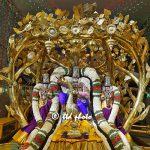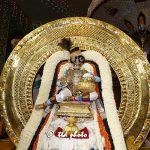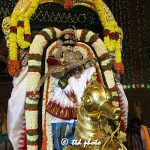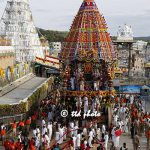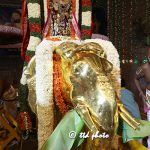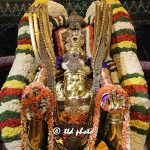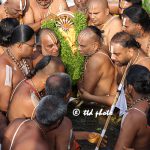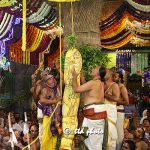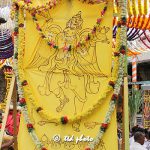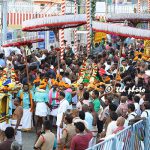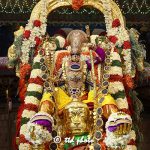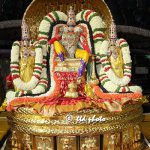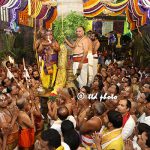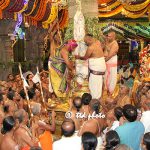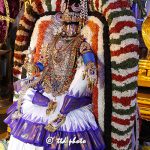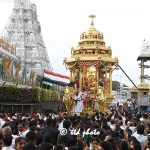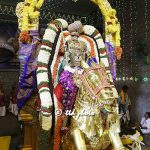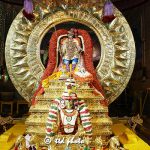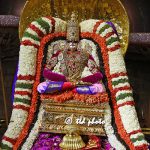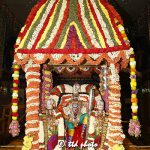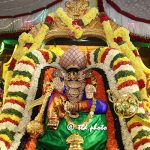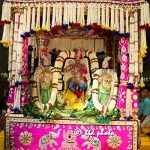BRAHMOTSAVAMS-THE NINE DAY CELESTIAL FETE OF LORD VENKATESWARA
Tirumala, 19 September 2017: Among the 450 odd religious events that are being observed in Tirumala temple all through the year, the nine-day mega religious fete observed in the month of Aswayuja as per the Hindu Lunar Calendar is considered to be most important of all as this is the festival believed to be conducted by the Creator, Lord Brahma and hence named after him as Brahmotsavams.
Ankurarpana:
On the evening before the start of the first day, the celestial rite “Ankurarpana” is performed where in nine types of seeds are sown in mud pots seeking the successful conduct of the Navahnika Brahmotsavams.
Dwajarohanam:
Dwajarohanam is a flag-hoisting festival that is held on the first day by hoisting a Garuda flag on the top of the temple mast amid Vedic chanting. It is believed to be a symbolic significance of formal invitation being extended to all the deities to attend the Brahmotsavam festival of Universal Lord.
Pedda Sesha Vahanam:
After the Dwajaarohanam the Lord is taken out in a procession in the evening on Aadi Sesha the thousand headed Chief Serpent as his vehicle. Aadisesha is the seat on which Lord Sri Mahavishnu rests in his abode Sri Vaikunta. Here the Pedda Sesha Vahanam has seven hood representing Seven Hills of Tirumala, since the Sesha Chala ranges are believed to be the incarnation of Adisesha in Kaliyuga.
Chinna Sesha Vahanam:
On the second day morning the Lord is taken out in a procession on Vaasuki (another Serpent God) as his vehicle. In Bhagavath Geetha Lord Sri Krishna says He is Vaasuki among the serpents. Chinna Sesha Vahanam is five hooded. It is with this mighty serpent Vasuki the milk ocean is churned to procure Amrita and various celestial objects.
Hamsa Vahanam:
On the second day evening the Lord is again taken out in a procession on Hamsa (Swan) as his vehicle. Hamsa or swan means ‘pure’. Hamsa is believed to have a high intellectual capability and can distinguish good from bad. In the guise of Goddess Saraswathi holding veena and book in either of his hands, Lord enlightens the devotees that he is Parabrahma Paramahasa Swarupa.
Simha Vahanam:
On the third day morning the Lord is taken out in a procession on ferocioua Simha vahana. Lion is a symbol of royalty and power. Lord assumed the form of half man and half lion in his Narasimha Avathara. Lord Sri Krishna says in Bhagavath Geetha that he is the Lion among the animals. To showcase his power and at the same time his patience, Lord as Yogamurthy charms devotees on Simha Vahana.
Muthyala Pallaki Vahanam:
On the evening of the third day, the Lord along with his consorts Sri Devi and Bhoo Devi grace on a palanquin decorated with a canopy of pearls. Pearl is said to be a symbol of purity and royalty.
Kalpa Vruksha Vahanam:
On the fourth day of the festival the Lord is taken out in procession in the morning on Kalpa Vruksha as his vehicle signifying that he is the giver of boons to his devotees and fulfills their wishes. Kalpavruksha is said to be the divine tree which has the power to fulfill the wishes.
Sarva Bhoopala Vahanam:
On the fourth day evening the Lord is taken out in a procession on Sarva Bhoopala Vahanam signifying that He is the Universal Lord of Lords.
Mohini Avatharam:
On the fifth day morning the Lord in the attire of Mohini, the celestial damsel charms the devotees. All Vahanas will start from vahana mandapa which is opposite the main temple, but Mohini avatharam starts directly from the temple with Lord on one palanquin and Lord Krishna on another.
Garuda Vahanam:
On the fifth day evening the Lord Sri Venkateswara is taken out in procession specially decorated, favourite vehicle Garuda-the mighty king of birds as his vehicle. It is a unique occasion where lakhs of pilgrims gather together to witness the fete. While all the other vahanams lasts for two hours, Garuda Vahana lasts for over five hours.
Hanumantha Vahanam:
On the sixth day morning the Lord is taken out in procession with Lord Hanuman as his vehicle. Hanuman was the personification of the most trusted and self less service. To show that He is always with His noble followers, Lord takes ride on Hanumantha Vahanam.
Swarna Rathotsavam:
On the sixth day evening the Lord is taken out first for Swarnarathotsavam and then in procession along with His two consorts Sridevi and Bhudevi to mark His splendor.
Gaja Vahanam:
By taking celestial ride on Gaja Vahanam, the Lord enlightens His devotees not to be proud of their mightiness as it may end in their debacle showcasing the example of Gajendra Moksham where He comes to the rescue of the Elephant King only he prays Lord after he was attacked by the crocodile.
Surya Prabha Vahanam:
On the seventh day morning the Lord Venkateswara is taken out in procession with Sun God driving the Chariot. Purusha Sooktha describes Sun as born from the eyes of Lord Srimannarayana (Chakshusho! Suryo Ajayathah!). Sun is also said to be an incarnation of Lord Maha Vishnu and hence Lord takes ride on Suryaprabha Vahanam as Surya Narayana Murthy.
Chandra Prabha Vahanam:
On the seventh day evening the Lord is taken out in procession with Moon as symbol of his vehicle. Purusha Sooktha describes Moon as “Chandrama Manaso Jaathaha” (Moon is born from the mind Lord Maha Vishnu). Moon is the commander of mind and is a symbol of pleasantry. By taking ride on Chandraprabha, Lord gives soothing feel to devotees.
Rathostavam:
On the penultimate day (eighth day) morning, Sri Malayappa Swamy is taken out in procession along with his consorts seated on a fully decorated mammoth wooden Chariot pulled by the devotees with the chanting of Govinda Nama Smarana. Tirumala will be flooded with devotes to witness this occasion.
Ashwa Vahanam:
On the eighth day evening the Lord is taken out on a procession on Aswa (Horse) as his vehicle symbolizing the forthcoming Kalki Avathara.
Chakra Snanam:
On the ninth day morning, last day of the Brahmostavams, special abhishekam known as Avabhrutha Snanam is held for processional deity Malayappa and his consorts Sridevi and Bhudevi along with Sudarshana Chakra (Disc weapon of Lord) at Varaha Swamy temple on the banks of Swamy Pushkarini. Later, the Sudarshana Chakra is immersed in the waters of Swamy Pushkarini. Large number of devotees will take a dip in the water of Pushkarini simultaneously with Chakrattalwar.
Dwajaavarohanam:
On the ninth day evening the Garuda flag will be lowered as a mark of completion of the Brahmostavams. The jeeyangas will be there along with priests. The priests will then lower the Garuda Dwaja marking the successful completion of the nine day fete.
ISSUED BY PUBLIC RELATIONSOFFICER, TTDs, TIRUPATI

